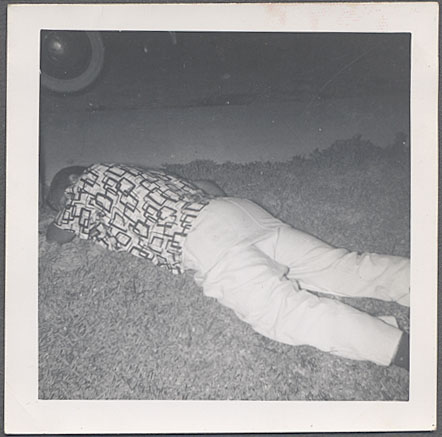Schwarz
View current page
...more recent posts
"Modernism has been popularly depicted as something that really is not very popular," Sies says, "that is very cold, that is alienating and that sort of insists on a kind of design purity that makes it not necessarily amenable to human habitation."
Many of the notable Modern structures built in the Baltimore-Washington corridor are more "down to earth," she says. Custom and tract homes built in some parts of the suburbs were sited and designed to fit into the landscape, and used lots of wood and stone in addition to glass to establish visual connections with the surrounding environment.
"We really use the term 'baby boom Modernism' to summarize the kind of houses and churches and office buildings and shopping centers that went up in post-World War II suburbs," Sies says. "Architects told us that is where the money was, where people were moving."
While some notable Modern structures in the state have been recognized, including Frank Lloyd Wright homes in Baltimore and Bethesda and a Neutra building at St. John's College in Annapolis, the University of Maryland professors' survey highlighted lesser-known sites such as Baltimore's Highfield House condo building, designed by Mies van der Rohe; Goucher College's Towson campus; and several synagogues and churches in the suburbs.
Some exceptional Modern buildings have undergone alterations over the years, Sies says, but few in the state are as important as the Comsat building. She says it is one of the most significant early works by Pelli, an Argentina native who designed Ronald Reagan Washington National Airport as well as some of the world's tallest buildings. His structures often feature curves and metal, and the Comsat building "sort of telegraphed his style," she says.
I've [Fatherflot] been working in my spare time on two projects near to my heart: a freeform webcast station for my university and a "Media Ecology" course with a large online database of readings.
As I've moved towards the stage of justifying each project I've begun to see a lot of connections. A true freeform radio station is a kind of educational institution, after all, serving as an evolving commentary upon/critique of commercial radio (in the case of WFMU, with its world-class "faculty" and "facilities," that critical engagement extends pretty much to the entirety of mass culture). The freeform ethos, in other words, is collective cultural criticism in practice. And while my main response to this practice is to encourage it, support it, tell others about it, and finally, to emulate it, there's nothing like a little theory to illuminate the practice.
Thus, I thought it might not be totally out of place to share some of the links I've found to the more important short works of cultural theory which are available on the web. If you like, we can use the comment section to discuss these texts and to suggest others if you know where they can be found. Here, in no particular order, are some of the biggies I've found:
Theodor Adorno and Max Horkheimer - "The Culture Industry: Enlightenment as Mass Deception"
Georg Simmel - "The Metropolis and Mental Life"
Guy Debord - "The Society of Spectacle"
Jean Baudrilliard - "Simulacra and Simulations"
Clement Greenberg - "Avant Garde and Kitsch"
Walter Benjamin - "The Work of Art in the Age of Mechanical Reproduction"
Susan Sontag - "Notes on Camp"
Roland Barthes - "Myth Today"
C.P. Snow - "The Two Cultures"
Neil Postman - "The Humanism of Media Ecology"
Neil Postman - "Five Things We Need to Know About Technological Change"
Marshall McLuhan - "The Playboy Interview"
Marshall McLuhan - "Understanding Media - Chapter One"
Steve Talbott - "Computers, The Internet, and the Abdication of Consciousness"
Steve Talbott - "Owen Barfield: the Evolution of Consciousness"
Umberto Eco - "The Future of the Book"
Walter Ong - "Orality, Literacy, and Personality"
Walter Ong - "Media Transformation: Electronics and Printed Books"
Susanne Langer - "A Note on The Film"
Alfred Korzybski - "The Role of Language in the Perceptual Process"
Jacques Ellul - "The Humiliation of the Word"
Jacques Ellul - "The Technological Bluff"
Jose Ortega y Gasset - "The Revolt of the Masses"
Slavoj Žižek - online links page at Lacan.com
another set...

Now DJ Drama is yet another symbol of the music industry’s turmoil and confusion.
On Tuesday night he was arrested with Don Cannon, a protégé. The police, working with the Recording Industry Association of America, raided his office, at 147 Walker Street in Atlanta. The association makes no distinction between counterfeit CDs and unlicensed compilations like those that DJ Drama is known for. So the police confiscated 81,000 discs, four vehicles, recording gear, and “other assets that are proceeds of a pattern of illegal activity,” said Chief Jeffrey C. Baker, from the Morrow, Ga., police department, which participated in the raid.
Mr. Kaczynski, 64, is in a legal battle with the federal government and a group of his victims over the future of the handwritten papers, which include journals, diaries and drafts of his anti-technology manifesto.
sanford and son t-shirt
The first thing everyone tells you about the New Canaan, Connecticut, house Eliot Noyes built for his family is that you have to go outside—outside!—to get to the bathroom. In 1954 architect and industrial designer Noyes made the separation of public and private life complete—bedrooms and baths on one side of an open courtyard, kitchen-living-dining on the other. “We used to tell our friends there was a tunnel from one side to the other,” says Fred Noyes, third of the four children. But really that walk outside was no big deal—short, covered, and from one radiant-heated stone floor to the other. “Try it sometime if it snows,” his brother, Eli, says. “Take your shoes off, run out into the snow for ten seconds, and run back in. It is actually cold and refreshing. We used to do that all the time.” Nonetheless, when Marcel Breuer’s client Edith Hooper requested a similar house, she made it clear she wanted the simplicity of Noyes’s design—but with a breezeway that could be enclosed in winter.
The empty streets, deserted avenues and abandoned houses prompt a gnawing question, nearly 17 months after Hurricane Katrina: Is this what New Orleans has come to — a city half its old size?
stone farmhouses bucks county pa
sellerville $249,900.00 (pros:pool)
newtown stone modern (cons: surban setting) $399,900.00
ivyland $399.900.00
green lane $349,900.00
quakertown stone barn $335,500.00
map codes
on now streaming
Wednesday, January 17th, 7pm - 8pm: Sounds of Soviet Animation
From the 1950s-1990s, the USSR was home to an immense body of remarkable animated films. Whether surrealistic, political, or dreamlike, they utilised a stunning array of techniques and ideas in the midst of a brutal political climate. The January 17th edition of Phuj Phactory will comprise a one-hour mix of music and sound-design taken from over thirty Russian animations, including 'Tale of Tales', 'Liberated Don Quixote', 'Butterfly', 'A Man in the Frame', and 'Mountain of Dinosaurs'.
extrude-o house - its back!
plug and play house construction
"Look at that," Kieran says, leading me into a small, tidy space filled with neat bundles of flexible orange tubing. Bolted to the wall is a row of black manifold boxes, each the size of a coffee cup. "It's beautiful. It's like the engine of a car." He's right; it looks less like a typical utility space – meters and junction boxes crammed with wires that splay off in all directions – and more like a piece of industrial design, crafted with planning and precision. And for good reason: This room and two more like it hold the house's high tech systems. It arrived at the site as a single unit stuffed with a tankless water heater, pumps, and other equipment ready to hook into the air, water, data, and power systems.
[....]
In 2001, after studying how the automotive, aircraft, and shipbuilding industries had revolutionized themselves over the previous 15 years, Kieran and Timberlake realized that architecture needed the equivalent of an integrated circuit. They began to combine glass, drywall, pipe, and wood frames into finished units, each precision-engineered for cost, beauty, and sustainability. In the Loblolly house, the walls and floors are made of panels (some as tall as 21 feet) that were manufactured with wiring, insulation, plumbing, and ductwork already in place. And the main power systems of the home, including two bathrooms and the galley kitchen, were delivered to the construction site in preassembled, plug-and-play units. After the site was prepared, the 2,200-square-foot house took three weeks to assemble.
memo to self - need a guy who can restore a couple of fifty cent piece size chips in a great tub - not re-coat - i saw an ugly tub truck on the block today.
bob brunquists worlds largest skateboard ramp vid from nyt
allentown hippies

“I call them elephant droppings,” he said. “Fuller’s idea was that of a machine-made object, a pure geometry.”
Most dome dwellers are not so picky.
nesthesiaRobert Stone reflects on how the 1960s changed him, and the rest of the country, in Prime Green.
While many of the city's homes were wrecked beyond salvation and clearly need to be demolished—Lentz's own historic house in the Tremé neighborhood was partially knocked over by Katrina winds and subsequently carted away—Lentz and others are becoming alarmed that so many of the city's homes in historic districts are being torn down, often with flood damage used as a pretext. It's as if New Orleans is now at risk of being ravaged by another flood—that of demolitions.
"New Orleans' incredible inventory of historical structures forms its single most valuable resource," says Richard Campanella, associate director of the Center for Bioenvironmental Research at Tulane University and author of a much-praised book, Geographies of New Orleans: Urban Fabrics Before the Storm. "Tearing them down when other options exist is a lazy, short-sighted decision that will be regretted by future generations."
generic names for soft drinks
via vz
its a clean machine

